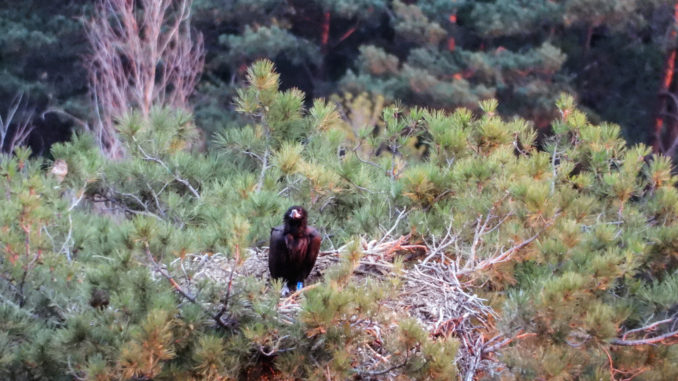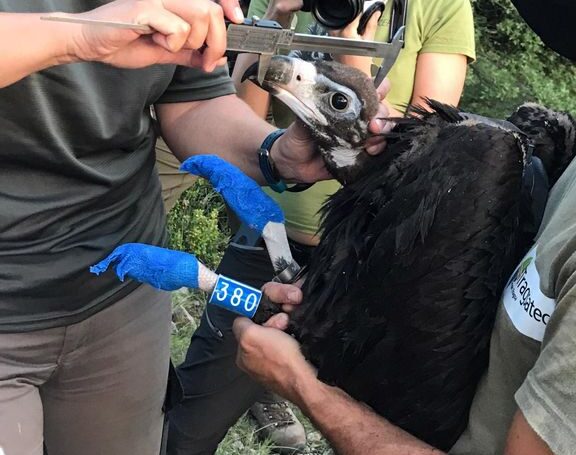
Researchers have determined an endangered vulture in Spain was poisoned by a veterinary medicine banned in other parts of the world.
The cinereous vulture (Aegypius monachus), sometimes called a black vulture, was found dead in its nest last September at the Boumort Wildland, an ecotourism nature reserve in the Catalan Pyrenees region of northeastern Spain.
The fledgling had learned to fly just 10 days earlier, authorities said.
It also ingested diclofenac, an anti-inflammatory drug banned for veterinary use in many countries, due to its devastating effect on carrion bird populations, particularly vultures.
Diclofenac causes severe kidney failure in vultures, but in 2013, Spanish authorities approved its use for livestock purposes — despite evidence the decline of Asian vulture populations stopped when it was banned there.
Spain is home to the largest population of vultures in Europe, but the birds’ numbers are declining. The International Union for Conservation of Nature’s Red List shows that the cinereous vulture has been threatened since 1988.

The dead fledgling was discovered as vultures are monitored and controlled through GPS technology, said Marta Herrero-Villar, a researcher at the Institute for Game and Wildlife Research.
“Thanks to an analysis of its stomach contents and a toxic analysis, it was confirmed it had died of diclofenac poisoning,” Herrero-Villar said.
Research published by Herrero-Villar and fellow researchers in the journal Science of the Total Environment in April states the vulture was suffering from severe visceral and articular coagulation caused by the drug.
Professor Rafael Mateo, also with the institute, said while it is unknown how diclofenac passed to the vulture, “it must be from the diet, taking carrion from an animal treated with this anti-inflammatory. Two days before, the same bird was seen alive and apparently in good health during a routine patrol.”
The bird had been seen feeding on rubbish in the reserve where it lived.
No other animals have died in the area through diclofenac poisoning, including the fledgling’s parents.
When a cow or pig is treated with diclofenac, Mateo said, “the medicine spreads through its body causing the effect that it is meant to do, and slowly the levels of the medicine decrease, except in the injection point, where high levels of this medicine remain for days.
“We believe it was bad luck the bird ate exactly that part of the injection site with higher levels of diclofenac.”
Conservation groups and researchers have been lobbying for the drug to be banned in Europe.
Though the European Medicines Agency recognizes the risk of veterinary diclofenac to vultures, it decided current livestock management processes were sufficient to prevent it entering the vulture food chain. The agency recommended EU member states develop further risk management measures, such as regulations and veterinary controls, to avoid poisonings.

Mateo said following the medicine’s guidelines to prevent an animal treated with it from becoming food for wild fauna would prevent vulture deaths. But he said that’s difficult to accomplish. “Knowing there are other nontoxic anti-inflammatories on the market that are safer for vultures and other animals — the more logical thing would be to ban it for livestock that are commonly the food source of those animals.”
Even a low dose of diclofenac will have a toxic effect on vultures; it’s more deadly than classic poisons.
Cinereous vultures grow 3.3 feet long with an 9.8-foot wingspan. They are considered the biggest birds in the Iberian Peninsula and one of the largest on the European continent.
Mateo said they are crucial to the ecosystem as they dispose of dead animals and control the spread of disease by removing pathogens from rotting carcasses.
Only 500 individual birds remained in the 1980s, he said. Now, thanks to different projects, they number around 2,500 breeding couples.
Several vulture recovery programs across Spain are hoping to connect the populations in the Iberian Peninsula with nearby France to create a European corridor so vulture numbers can be strengthened.
(Edited by Judith Isacoff and Fern Siegel)
The post Endangered Vulture In Spain Killed By Toxic Medicine Banned In Other Countries appeared first on Zenger News.
